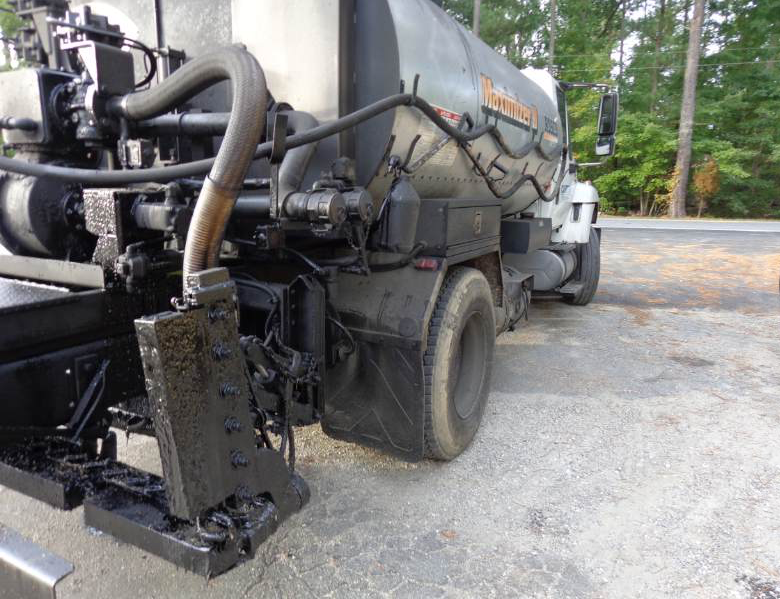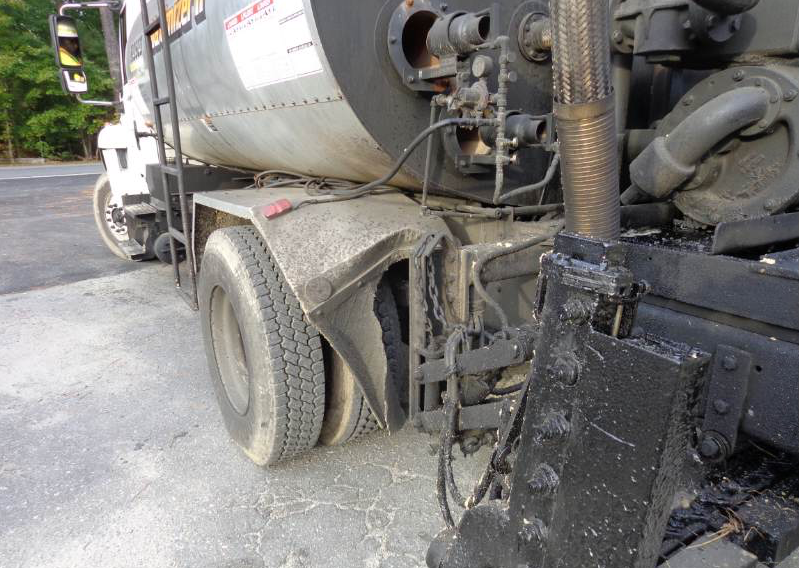How to Get Ahead During the Downtime
BY AsphaltPro Staff

It’s easy to overlook maintenance activities when you’re busy with projects during the paving season. Production, more tons, uptime, and other mantras from our make-hay-while-the-sun-shines business practices keep our eyes on working the job at hand, not necessarily cleaning and maintaining the equipment that keeps the job going smoothly. The folks at Caterpillar released some information in their Nov. 5 Cat Heavy Construction Equipment newsletter that shows the construction industry average of preventive maintenance hours spent is 35 percent, and the industry average of dollars spent on maintenance costs is 8 percent of revenue. Their author asked, “[D]o you want to run your company like an average one, or do you want to model your business decisions after companies who are out ahead of the industry?”
At first, the idea of spending 3.5 hours out of every 10 on preventive maintenance seemed outlandish. Is that amount of time necessary? The paver should be in the field laying beautiful mats. The compactor should be rolling those mats to smooth perfection. Neither machine should be sitting in the workshop bay while a mechanic scrutinizes some tiny part with a magnifying glass.
Or should it?
As reported in the December issue’s equipment gallery, the team at Atlas Copco has launched a whole new structure for making equipment rental centers more efficient. The company states it’s the first equipment manufacturer to offer multiple service centers throughout the United States specifically to support rental centers. They’ve built eight service centers to handle the “big” projects such as clutch replacements, coupling changes and refurbishments that rental companies might not have the expertise to perform. This clears the rental center’s schedule for minor calls and critical items that key customers need taken care of immediately.
Now that’s the repair segment of maintenance. That’s the kind of downtime you want to avoid by putting preventive maintenance time into your weekly activities. (We’re not even talking about the cost of the actual parts, shipping charges, labor, etc. incurred during an unplanned downtime event.) So the answer to the question is yes. Yes, crews do need to put adequate time into preventive maintenance to keep equipment up and running smoothly. Unfortunately, 35 percent of time spent is a questionable industry average, and the Equipment World survey from which Cat got its information could undergo review.
“That’s absolutely wrong,” John Ball said. “Preventive maintenance does not happen the way it should. There’s not even an incentive out there to get employees to perform maintenance the way they should. You’re lucky if you have half an hour at the end of the shift for maintenance. Even if it’s a veteran crew that knows better, they’ll get back to the yard, shut down and go home. They don’t even wipe down the lights or the mirrors. We have gorgeous backup mirrors and cameras on the new Hamm machines that are out now and these guys aren’t maintaining them to keep them safe. That has to change.”
A contractor in South Florida who wished to remain anonymous had a skid steer loader undergoing repairs at press time. The problem? One of the crew members left the diesel cap off after filling the tank. On one hand, the supervisor was pleasantly surprised that the crew member had taken the time to “gas up” the machine prior to leaving after his shift one night. On the other hand, the supervisor was angry because his crew now has a couple thousand dollars in repairs; the local mechanic has been cleaning debris from the tank and connected systems in the machine. Those are billable hours while the skid steer is down.
The problem with the skid steer might have been averted if workers had been paying attention to routine machine checks at the end of their shift. That time, Ball said, is the opportune time to clean equipment and prevent future problems. For example, another company that will remain anonymous left the spray bars of the distributor truck caked with material after multiple uses rather than taking advantage of cleaning up heated, malleable, more liquid tack at the end of the shift.

While this distributor truck helps us understand the importance of cleaning tack spray bars while they’re still warm, it also shows some other problems. Do you see what’s wrong in this picture? A Department of Transportation official could stop this driver and fine the company for the missing mud flap. What else do you see that needs repair? Photo courtesy of John Ball, Top Quality Paving.
“With tack, it’s very hard to get any mess off the bar or the nozzles,” Ball said. “You can use a release agent, but you have to put a lot on there. For tack, you’ve got to get at it while it’s nice and hot. You must get at it while the machine’s still hot. Clean it while you’re still on the job at the end of the shift to save yourself extra work, harder work or even downtime later.”
It’s not enough to be aware of these problems. Company owners and supervisors need to do something about the lack of preventive maintenance. The folks at Cat included an excellent list of tips in the Nov. 5 newsletter. Those are spelled out in the sidebar at xxxx. In essence, you want to create a preventive maintenance schedule with the assistance of available technology. Companies such as Roadtec out of Chattanooga, Tenn., have telematics like the Guardian software that keep track of hours the machine has been working, hours the machine has been idling, hours since the last rotor bar change, etc.
Be aware that simple preventive maintenance such as wiping down hopper wings, cleaning the spray bar on the roller’s drums, turning the nozzle on the striper to prevent drying in the tip, etc. are the general knowledge maintenance items that equipment operators won’t have technology telling them to do. You can check with your OEM for the latest telematics it offers to assist with monitoring maintenance activities, and then map your plan to make preventive maintenance a higher percentage of your schedule.
*****
Get Positive Preventive Maintenance
Create, post and stick to preventive maintenance schedules.
Construction accountants and financial advisors report that preventive maintenance schedules, when adhered to, are a best practice for maintaining the value of equipment and cutting down on repair costs.
Take a look at outsourcing as an efficiency booster.
Evaluate the maintenance and repair work that your team is doing—what’s being done, the number of hours and the cost of downtime. Also, look at the time involved to schedule and manage product inventory. It’s possible you could realize cost savings and convenience by outsourcing certain maintenance to a more efficient third party. If you have your shop handling maintenance for equipment and vehicles, you may want to consider outsourcing one fleet.
Use technology to make maintenance as efficient as possible.
The machine hour meter records the number of hours the machine is on, but it doesn’t differentiate between on time, working time and idle time. Various monitoring systems do make the distinction and this basic technology is integrated into many newer model machines. When you can look at the data and see which of the hours on the machine are actually working hours, you can schedule maintenance not off the hour meter, but using the actual time worked. This means you will reduce the number of preventive maintenance events needed annually.
For example, if you have a recommended service interval of 250 hours for a machine that has 70 percent working time, it means that approximately 30 percent or 75 hours of each 250 machine hours are non-working hours. So every fourth preventive maintenance event is due to the non-working hours alone, which is not a true indicator of use. With the more accurate data provided by technology, you will do preventive maintenance when it is needed and avoid unnecessary maintenance and the associated costs.
Technology also helps you keep track of machine health—proactively—with alert codes that let the operator know when the machine is operating outside of normal parameters or needs service. The overall result will be fewer failures, less downtime and reduced cost.
Source: Cat Heavy Construction Equipment, Nov. 5, 2014
[Company Name Here]
Equipment #: Current Hours: EQUIPMENT INSPECTION REPORT OFF-ROAD Date:
TPR Standards on Machine? Yes No
Inspector (print name): Foreman (print name):
(first box)
Comp # Fluids Levels Amt. Added Leak Location Comments for Fluids
B01 Engine Oil Proper Level Low Level Qts
N01 Antifreeze Proper Level Low Level Gals
I01 Hydraulic Oil Proper Level Low Level Gals
I01 Hydraulic System Leak Free Leaks
F01 Brake Fluid Proper Level Low Level Pts
D25 Pump Drive Box Proper Level Low Level Qts
D25 Transmission Oil Proper Level Low Level Qts
Comp # Implements Condition
M20 Bucket Acceptable Missing/Worn
M20 Bucket (teeth) Acceptable Missing
L01 Cutter Drum (holders) Acceptable Missing
L01 Hardfacing Acceptable Worn
L01 Holders Acceptable Worn/Missing
Comments for Implements
Comp # Engine Condition Comments for Engine
N01 Cooling System Fine Clean Fins Dirty
N01 Cooling System Leak Free Leaking
B25 Engine Exhaust Acceptable Leaks
B60 Fuel System Acceptable Leaks
N01 Belts (condition) Acceptable Worn
N01 Belts (tension) Acceptable Tight/Loose
N01 Belts (sound) Acceptable Squealing
E01 Battery Acceptable Add Water
Comp # Operator Station Condition Comments for Operator Station
G01 Seat Acceptable Operational/Torn
E01 Electrical (fuse cover) Acceptable Missing
E01 Exposed Wires Acceptable Frayed
E01 Lights Acceptable Not Working
N50 AC/Heating Acceptable Heating/Cooling
B70 Lubrication System Acceptable Damaged Fittings
B50 Auto Lubricator System Acceptable Damaged Lines
I01 Hydraulic System (power) Acceptable Loss of Power
I01 Speed Acceptable Slow Operation
I01 Controls Acceptable Sticking
B50 Air System (air filter and hoses) Acceptable Red Zone
G01 Gauges (volt meter reading) Voltage Reading
G01 Oil Pressure Reading Engine Oil Pressure Reading
G01 Engine Water Temp Engine Water Temp Reading
Comp # Tires Condition Comments for Tires
H01 Left Front Acceptable Worn
H01 Right Front Acceptable Worn
H01 Left Rear Acceptable Worn
H01 Right Rear Acceptable Worn
H01 Left Middle Acceptable Worn
H01 Right Middle Acceptable Worn
(sixth box)
Comp # Tracks Condition Comments for Tracks
J01 Track Acceptable Tight/Loose
D75 Final Drives Left Acceptable Worn
D75 Final Drives Right Acceptable Worn
Comments:
I have performed my daily OSHA INSPECTION and informed my foreman of all deficiencies.
Inspector’s/Operator’s Signature:
Comp # Body/Appearance Condition Comments for Operator Station
G01 Paint Acceptable Poor
G01 Decals Acceptable Damaged
G01 Doors Acceptable Dented
G01 Steps Acceptable Bent
G01 Glass Acceptable Cracked
G01 Mirrors Acceptable Damaged
G01 Vandalism Guards Acceptable Damaged/Missing
Comp # Safety Item Condition Comments for Safety
E01 Back-up Alarm Acceptable Too Low
G01 Seatbelt Acceptable Will Not Latch
G01 Horn Acceptable Not Working
F01 Brakes Acceptable Will Not Stop
A50 Steering Acceptable Loose/Hard
G01 Fire Extinguisher Acceptable Not Charged
G01 Roll-Over Protection System Acceptable Damaged
Note: A phone call is required to a mechanic or supervisor when a phone icon is next to a checked component item.
Equipment inspection form courtesy of John Ball, Top Quality Paving
